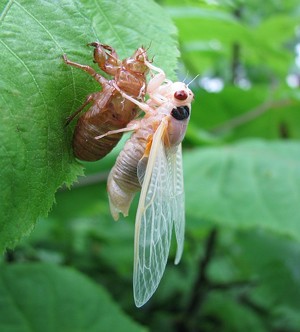
Eclipse watchers protected their eyes. When the periodical cicadas arrive, you may want to cover your ears. "The songs of male cicadas can be louder than a chain saw at full throttle," said Guy Sternberg of Starhill Forest Arboretum in Petersburg. He knows from personal experience. During the previous 17-year emergence, Sternberg counted areas with molted exoskeletons and estimated there were 50 million cicadas on his 50-acre arboretum. The sound rattled the windowpanes on his house. While the males make the noise, the females damage trees by using their ovipositors to cut slits in pencil-diameter tree branches to deposit their eggs.
Cicadas don't bite, sting or carry any diseases. They are harmless to people and pets. Don't panic, and don't apply pesticides, which will not be effective. These insects are not locusts. Cicadas have modified mouth parts to feed on tree sap, and they won't eat plants, shrubs and bushes. "Their sole purpose is to breed and lay eggs," said Sternberg.
Periodical cicadas are smaller than the typical cicadas that occur here each year. They have bright red eyes and a black body with orange markings. "There are seven species of 13 and 17-year cicadas which differ in size, color, timing of chorusing and differences in songs," explains Susan Dees Hargrove, a retired biological resources specialist for IDOT. Brood XIII of the 17-year periodical cicadas generally occurs in the northern half of Illinois, and Brood XIX of the 13-year cicadas generally occurs in the southern half of Illinois. This year both will emerge simultaneously in Sangamon County and nearby.
Periodical cicadas spend most of their lives as nymphs, living underground and feeding off the sap of tree roots. They emerge to transform into adults and mate. The nymphs begin to emerge when the soil temperature reaches 64 degrees Fahrenheit eight inches below ground. They emerge primarily at night, molt and leave their shells behind. Males "sing" to attract females by flexing a membrane, called a tymbal, in their abdomen. They have a nearly empty body cavity which adds to the intensity of the sound. Females respond with a wing flip, indicating they are ready to mate.
Cicadas will fly, sing and mate once their body temperature reaches 72 degrees. After mating, the females can travel up to approximately 1,000 feet to lay eggs in small tree branches. They make a zipper-like slit with their ovipositor and lay 20 eggs at a time along the branch, with each female laying up to 600 eggs, according to Sternberg. This can cause the branch to die, droop or fall to the ground. The adults die; the larvae hatch into nymphs, drop to the ground and burrow underground for the next 13 or 17 years. The entire process lasts about four to six weeks.
Periodical cicadas are most prevalent in areas with mature trees, where nymphs have been living on tree roots for years. Open areas that lack mature trees are not likely to experience periodical cicadas. Young and newly planted trees in areas with more mature trees will be most vulnerable. Conifers are not typically used by cicadas due to their sticky sap.
Sternberg says young trees with a central leader reaching for the sky can be seriously affected, requiring pruning and training in the next few years to restore a central leader. Structural damage to trees may be less for trees with a spreading branch structure. Now is not the time to plant new trees. Delay planting new trees until after this spring's emergence.
The Morton Arboretum suggests homeowners ensure that susceptible trees are as healthy as possible by mulching, watering and addressing any disease issues. After leaves emerge and before the cicadas arrive, cover small trees with fine protective netting, such as tulle (available at fabric stories) or insect netting (available at landscape supply stores). Openings in the netting should not exceed a quarter-inch. Gather the fabric around the trunk as near to the ground as possible and close gaps with binder clips, clothespins or staples.
Why do so many cicadas emerge at the same time, and how do they know when 13 or 17 years has elapsed? The Morton Arboretum explains that cicadas have no natural defense mechanisms except their sheer number. When millions of cicadas are active at the same time, predators can't possibly eat them all, ensuring their ability to reproduce. Scientists aren't sure how cicadas know when a certain number of years have elapsed. However, it's believed the underground nymphs have an internal molecular clock that may track the yearly cycle of the trees upon which they feed.
Although the deafening noise and masses of dead cicadas on the ground may be annoying, enjoy this once-in-a-life-time miracle of nature. Thirteen and 17 are prime numbers, therefore mathematically it will be another 221 years before their emergence next coincides. Periodical cicadas have some benefits: the holes they make when emerging from the ground help to aerate the soil, cicadas provide food for wildlife and their decaying bodies provide nutrients for the soil and can be added to your compost bin.
Karen Ackerman Witter has a master's degree in ecology and enjoys experiencing miracles of nature.






















